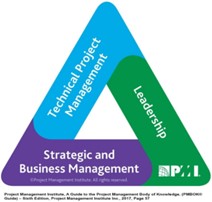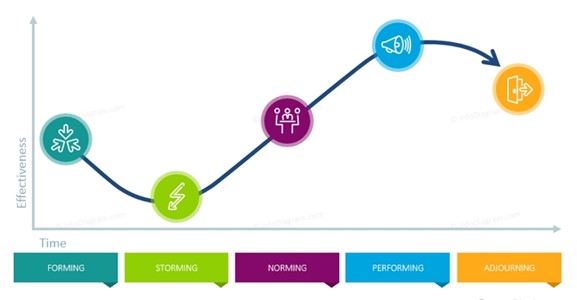Team development for high performance
| Line 24: | Line 24: | ||
| + | == Team development in relation to project management == | ||
| + | Bruce W. Tuckman's model for team development can be applied for the role of the project manager according to the standard “A Guide to the Project Management Body of Knowledge”, which is dealing with leaders and managers applying project management practices and tools to their work. The standard describes a framework for the skills needed by project managers through the use of The PMI Talent Triangle®. The talent triangle focuses on three key skill sets: Technical project management, Strategic and business management, and Leadership.<ref name=''name''> ''A guide to the Project Management Body of Knowledge (PMBOK guide), 6th Edition, 2017'' </ref> | ||
| − | [[File:PMI Triangle.jpg]] | + | [[File:PMI Triangle.jpg]]. <ref name=''name''> ''Project Management Institute. www.pmi.org'' </ref> |
| + | |||
| + | |||
| + | The model for team development is important to the leadership aspect. The project manager plays a critical role in the leadership of a project team in order to achieve the project’s objectives. A large part of the project management involves dealing with people. The project manager should study people’s behaviors and motivations to lead the team to obtain the goals. The leadership skills involve the ability to guide, motivate, and direct a team. These skills may include demonstrating essential capabilities such as negotiation, communication, problem solving and critical thinking. The team leader should be able to manage relationships and conflict by building trust, satisfying concerns, and developing personal and professional networks.<ref name=''name''> ''A guide to the Project Management Body of Knowledge (PMBOK guide), 6th Edition, 2017 '' </ref> | ||
| + | |||
| + | With these tasks to solve, fulfill and deliver, it is essential for the project manager to be concerned about the project team’s development through the project’s lifetime. The team leader should expect change and need to implement processes to manage the team members and keep the change in control. | ||
| + | |||
| + | |||
| + | == Groups, Teams and High Performing Teams == | ||
| + | The intention of developing the team is to reach the projects goals in the best possible way. When working in teams the overall performance and the final result will be improved. Some of the other purposes and benefits of working in a team are faster innovation, increase work flexibility, introduction of new technology and by motivation increase the members participation. | ||
| + | |||
| + | A group is identified by having individual goals and each member of a group is there to fulfil their own objectives. The members interact, exchange information, and share a common purpose, interest, or situation. The members of a group are not reliant on one another for their work, and so the final result is the sum of the work of each individual.<ref name=''name''> ''https://theinvestorsbook.com/group-vs-team.html'' </ref> | ||
| + | |||
| + | A team is organized and consists of individuals with competent skills and expertise, to achieve a common goal. Every individual in a team, is allocated specific roles to accomplish and together the members work as a single unit and take up the responsibility for the mutual project. Members rely on each other’s capabilities and skills and the collaboration is based on trust. | ||
| + | |||
| + | To reach the scope of the project it is important to form a team that can solve the task together. Often as quickly and with the lowest possible costs. To accomplish this, it will be easier if the team works well together and therefore can be as effective as possible. Therefor a team is more preferrable then a group. | ||
| + | |||
| + | |||
| + | |||
| + | |||
| + | |||
| + | <ref name=''name''> ''link/title'' </ref> | ||
Revision as of 19:56, 21 February 2021
Contents |
Abstract
This article deals with the people perspective of project management. When different people must work together in a team different workflows, norms and challenges will occur. The team members will all have different views on tasks and how they should be solved. The traditional project management consists of methodologies revolving technical and procedural factors, but even with those very well-established frameworks, projects can be failures. The behavior of people in a team is one of the factors that drive successful project management.[1]. If the people do not work effectively together, the chances for success and reaching the goals are extremely limited. To reach an effectively workflow and a high preforming team, it is important to consider the different types of personalities and how they affect each other. All members of a team, especially the team leader, should have in mind that different people have different characteristics and a preference for certain types of work and roles in the project.[2].
The project management should follow the project team’s development through their time together on a project. As the team forms it will move through several stages as it changes from being a collection of random people into a team and eventually into a high performing team. The development can be described in five stages. Bruce W. Tuckman's work describes these stages as Forming, Storming, Norming, Performing and Adjourning.[3]. These stages are essential in order to grow into a functioning effectively team, which can deliver high quality results. Although this is not a new way of thinking, it is still highly relevant and respected. Also, the model remains popular and useful to project management, as it provides valuable strategies to lead and develop the team. The theory can provide insight into what stage of development the team is at and how a leader should be able to manage the team and motivate them to be as high performing as possible.
Table of content
- Team development in relation to project management
- Groups, Teams and High Performing Teams
- Tuckman’s model for Team Development
- Forming
- Storming
- Norming
- Performing
- Adjourning
- Attract, engage and integrate to develop the team
- Limitations to the model for team development
- Conclusion and further work
- Annotated Bibliography
- References
Team development in relation to project management
Bruce W. Tuckman's model for team development can be applied for the role of the project manager according to the standard “A Guide to the Project Management Body of Knowledge”, which is dealing with leaders and managers applying project management practices and tools to their work. The standard describes a framework for the skills needed by project managers through the use of The PMI Talent Triangle®. The talent triangle focuses on three key skill sets: Technical project management, Strategic and business management, and Leadership.[4]
 . [5]
. [5]
The model for team development is important to the leadership aspect. The project manager plays a critical role in the leadership of a project team in order to achieve the project’s objectives. A large part of the project management involves dealing with people. The project manager should study people’s behaviors and motivations to lead the team to obtain the goals. The leadership skills involve the ability to guide, motivate, and direct a team. These skills may include demonstrating essential capabilities such as negotiation, communication, problem solving and critical thinking. The team leader should be able to manage relationships and conflict by building trust, satisfying concerns, and developing personal and professional networks.[6]
With these tasks to solve, fulfill and deliver, it is essential for the project manager to be concerned about the project team’s development through the project’s lifetime. The team leader should expect change and need to implement processes to manage the team members and keep the change in control.
Groups, Teams and High Performing Teams
The intention of developing the team is to reach the projects goals in the best possible way. When working in teams the overall performance and the final result will be improved. Some of the other purposes and benefits of working in a team are faster innovation, increase work flexibility, introduction of new technology and by motivation increase the members participation.
A group is identified by having individual goals and each member of a group is there to fulfil their own objectives. The members interact, exchange information, and share a common purpose, interest, or situation. The members of a group are not reliant on one another for their work, and so the final result is the sum of the work of each individual.[7]
A team is organized and consists of individuals with competent skills and expertise, to achieve a common goal. Every individual in a team, is allocated specific roles to accomplish and together the members work as a single unit and take up the responsibility for the mutual project. Members rely on each other’s capabilities and skills and the collaboration is based on trust.
To reach the scope of the project it is important to form a team that can solve the task together. Often as quickly and with the lowest possible costs. To accomplish this, it will be easier if the team works well together and therefore can be as effective as possible. Therefor a team is more preferrable then a group.
- ↑ https://www.projecttimes.com/articles/does-people-behavior-impact-projects-how-and-what-do-we-do-about-it.html
- ↑ Nigel Bennett, Managing Successful Projects with PRINCE2, 6th Edition, 2017
- ↑ https://www.clarityleadership.co.uk/blog/tuckman-model-team-formation
- ↑ A guide to the Project Management Body of Knowledge (PMBOK guide), 6th Edition, 2017
- ↑ Project Management Institute. www.pmi.org
- ↑ A guide to the Project Management Body of Knowledge (PMBOK guide), 6th Edition, 2017
- ↑ https://theinvestorsbook.com/group-vs-team.html
- ↑ link/title
